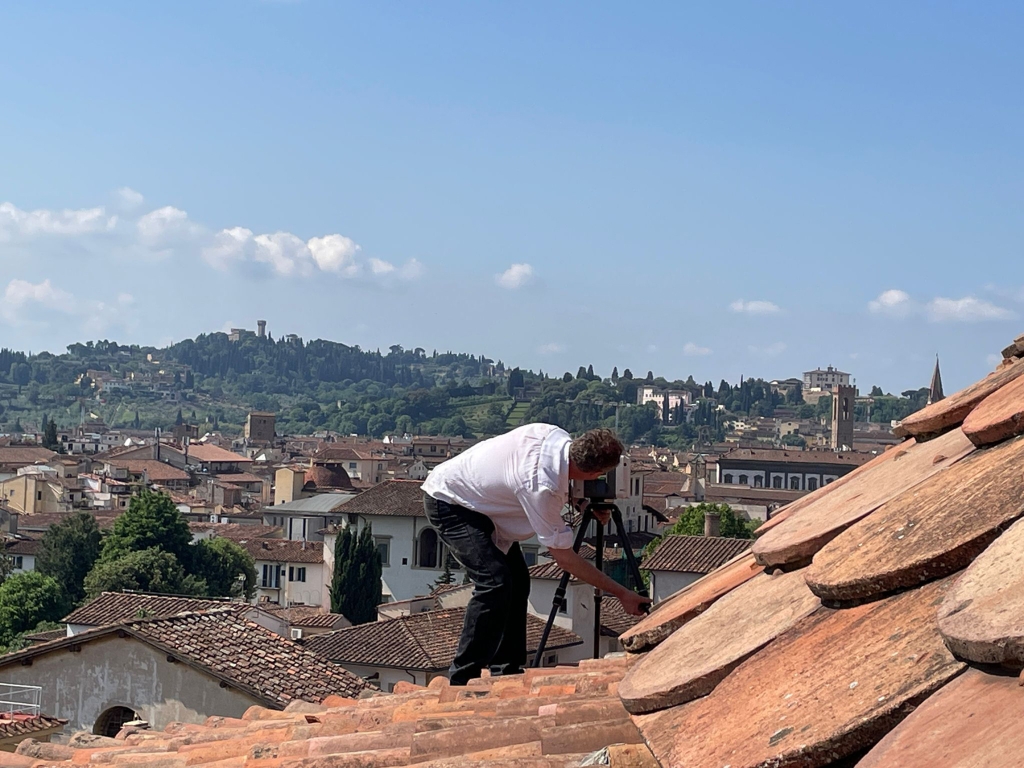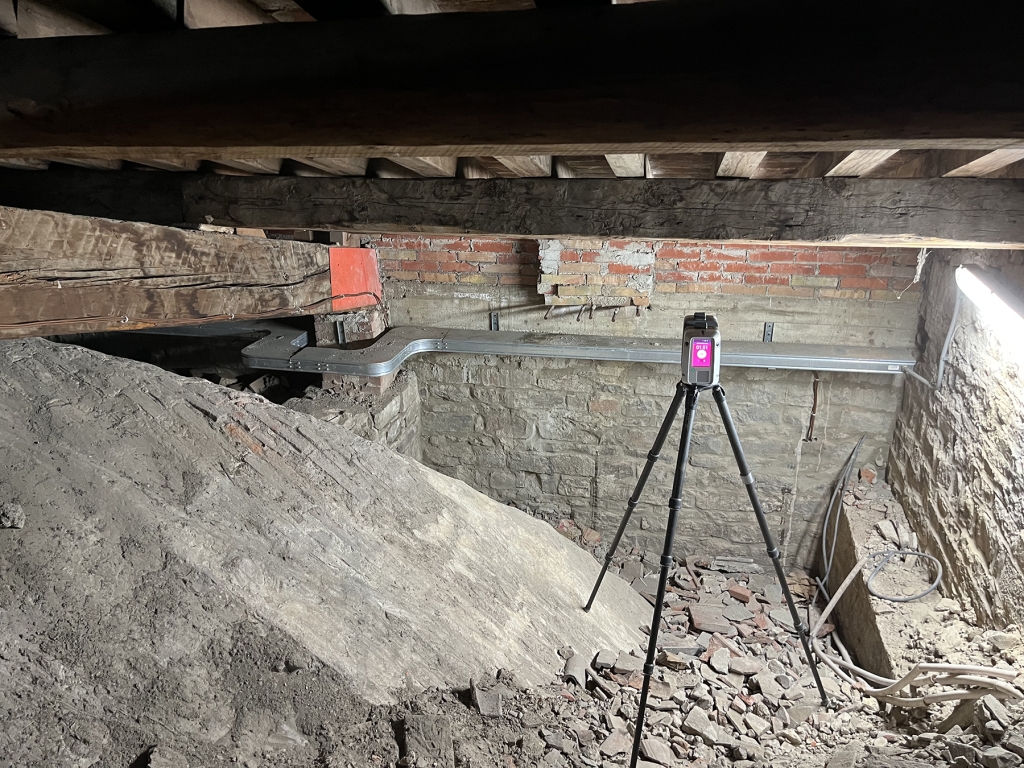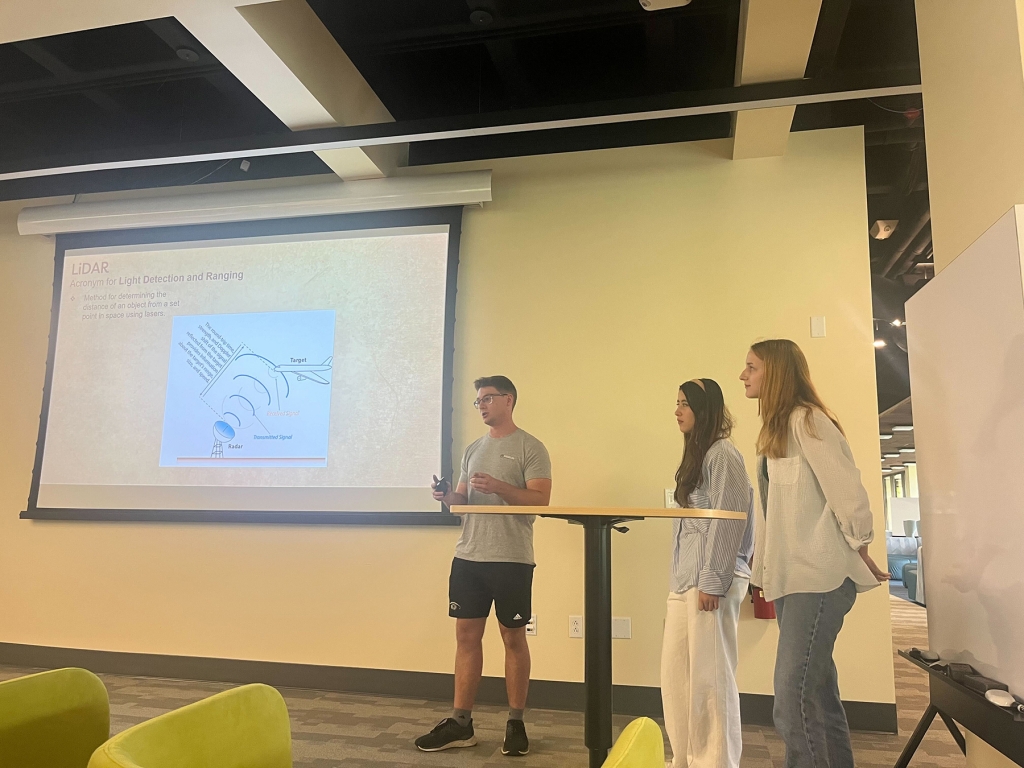Reconstructing the Past Summer Research Scholars are spending their summer helping to bring one of the world's oldest cities to life through modern technology.
“Over time, the computer scientists begin to learn the humanities part, and the humanities majors begin to learn the computer science part. At the end of the year, there’s this – as my adviser used to say – ‘Mozartian joining of hands,’ where everybody’s kind of all on the same page, harmonizing the same song by singing different notes. It’s really nice to see.”
~ George Bent, Sidney Gause Childress Professor of the Arts
In 1584, a friar in Florence, Italy, created a hand-drawn map of the city with incredible accuracy and detail. This summer, a group of Washington and Lee University Summer Research Scholars has continued his work using 21st-century tools to illuminate the city’s architectural layers.
A new cohort of undergraduate researchers has joined the ranks of more than a dozen students who have contributed to the “Florence As It Was” (FLAW) project. The project, begun in 2016, combines an interactive map with three-dimensional representations of buildings, designed according to measurements gleaned from the scholarly literature and on-site observation. Woven into these reconstructions will be images of original works of art situated in the places they were located during the Renaissance. “Hot spots” throughout these buildings and images will direct viewers to selected documents, descriptions and interpretations that explain the messages, functions, uses and reception of art and architecture in the past.
George Bent, Sidney Gause Childress Professor of the Arts, and his co-researchers, David Pfaff, senior academic technologist and director of the IQ Center, and Mackenzie Brooks, associate professor and digital humanities librarian, envision a virtual reality tour through the buildings that will enable users to recreate the visual experience of a 15th-century Florentine visitor. Bent said his partnership with Pfaff and the IQ Center consistently yields new approaches to the project. The latest innovation is Reality Capture, a process by which the point clouds are generated with the team’s LIDAR scanner. This remote sensing technology measures distances by illuminating a target with laser light and analyzing the reflected light. Scans are combined with high-resolution photographs, which are then stitched together to form the accurate geometry of the building.
“This allows for the richness in the image’s detail combined with the geometric accuracy of the point cloud,” Bent said.
Kelan Joiner ’27, an engineering major from Social Circle, Georgia, has gained expertise this summer in the Reality Capture process. Joiner has primarily made 3D models of portions of two churches using thousands of photos and laser scans.
“I wanted to get experience using different kinds of software and working with different technology before I start applying for engineering internships,” Joiner said. “This summer was a great opportunity to get into that work on 3D modeling and to work with point clouds.”
Pfaff said that over the years, the team has developed a workflow to get students up to speed quickly on the technological tools needed to continue the project.
“We’ve found it’s most effective to have them specialize,” Pfaff said.
Teresa Yoon ’26 said her SRS experience has allowed her to gain expertise she did not anticipate acquiring when she began her summer. Yoon has been working extensively with Cyclone Register 360, a software application for processing, visualizing and managing point cloud data. It is commonly used in surveying, construction and engineering for tasks such as Reality Capture, building information modeling (BIM) and infrastructure management. Cyclone Register 360 is widely used by professionals who work with detailed spatial information for projects ranging from small buildings to large infrastructure developments.
Yoon, a studio art and accounting major from Seoul, South Korea, said it is exciting to be involved with a project this ambitious in scope.
“I love the interdisciplinary approach of this research, particularly the combination of the 3D modeling and art history,” Yoon said, adding that working with Bent is an opportunity to gain expertise on the history of paintings and architecture represented in each image she works on.
“It’s like being in the model with a tour guide,” Yoon said.
Bent said Yoon’s background in studio art is an asset to the team.
“I’m always interested in studio art majors, because more of this project is art-based than meets the eye,” Bent said. “You need to be making qualitative judgments at every turn, and having a good eye really matters.”
Bent said the interdisciplinary exchanges that happen as students work on the project in cohorts has been a consistent highlight of all his research teams.
“Over time, the computer scientists begin to learn the humanities part, and the humanities majors begin to learn the computer science part,” Bent said. “At the end of the year, there’s this – as my adviser used to say – ‘Mozartian joining of hands,’ where everybody’s kind of all on the same page, harmonizing the same song by singing different notes. It’ s really nice to see.”
The project has received international support and recognition over the past eight years; the team recently received a grant from the Samuel H. Kress Foundation to support student research work, and the project was featured in a case study and documentary produced by Leica Geosystems, a Swiss surveying company whose 3D laser-scanning products have been used to create the digital reconstruction of Florence. The team is also part of a consortium that was selected by The National Endowment for the Humanities (NEH) to receive one of the organization’s Humanities Collections and Reference Resources (HCRR) grant for the next two years.
Abbie McGuinness’ work this summer offers a tremendous benefit to the consortium. McGuinness ’27 began transferring all the written data about each object cataloged in the project to Wikidata, a relative site to Wikipedia, to better the query service used in conjunction with the interactive map. The FLAW digital platform will eventually have additional interactive features such as the ability to navigate through different periods, view annotations and access multimedia content related to the city’s history, making accurate data that is accessible to other researchers around the world a crucial foundation for the project’s success. McGuinness, an art history major from Virginia Beach, Virginia, said this experience, as well as Brooks’ mentorship, has made her excited to take more classes toward the digital culture and information (DCI) minor.
Bent has received Lenfest Grant funding since 1993, which has helped him continue his research even during stints as chair of the department of art and art history and as associate dean of the college. This has led to several paper presentations, multiple articles in scholarly journals and two books, including his latest work, Public Pictures and Visual Culture in Early Republican Florence (Cambridge University Press, 2016). W&L’s Staniar Gallery recently hosted an exhibition titled “Florence As It Was: The Digital Reconstruction of a Renaissance City,” which was on view in the Lenfest Center for the Arts from Feb. 13 through March 25, 2024.
FLAW is an endeavor Bent says may well continue for the rest of his professional life, noting that he and his team hope to imbue their work with a sensitivity to the cultural and historical significance of the sites and artifacts it reconstructs.
“We want to be incredibly careful about documenting every change we make, and making it clear that this is also speculative,” Bent said. “Ideally, there will be two models available to people — one with a particular building as it is today, then what our hypothetical reconstruction looks like, so that visitors to the site can compare and contrast these two versions as they decide for themselves whether our solutions have merit.”
If you know any W&L students who would be great profile subjects, tell us about them! Nominate them for a web profile.
 George Bent sets up a scanner on the roof of a building in Florence on a recent trip to gather images.
George Bent sets up a scanner on the roof of a building in Florence on a recent trip to gather images. FLAW researchers in the IQ Center
FLAW researchers in the IQ Center Scanning the rafters of the Dominican convent and cloisters of Santa Maria Novella in Florence.
Scanning the rafters of the Dominican convent and cloisters of Santa Maria Novella in Florence. Yoon, Joiner and McGuinness present their findings at the SRS Brown Bag Lunch Series in the Harte Center.
Yoon, Joiner and McGuinness present their findings at the SRS Brown Bag Lunch Series in the Harte Center.
You must be logged in to post a comment.